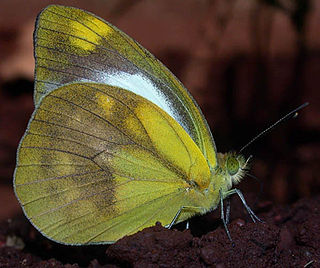
Gerosis bhagava, the common yellow-breast flat, is a butterfly belonging to the family Hesperiidae. The species was first described by Frederic Moore in 1865.

Cepora nadina, the lesser gull, is a small to medium-sized butterfly of the family Pieridae, that is, the yellows and whites. The species was first described by Hippolyte Lucas in 1852. It is native to Sri Lanka, India, Myanmar, Hainan, and southeast Asia.

The Museum of Contemporary Art (MOCA) is a collecting museum located in North Miami, Florida. The 23,000-square-foot (2,100 m2) building was designed by the architecture firm Gwathmey Siegel & Associates Architects, New York City.
Phylopatris is a genus of moth in the family Gelechiidae. It contains the single species Phylopatris terpnodes, which is found in Brazil (Amazonas) and Peru.
Moca is a genus of moths in the family Immidae. The genus was erected by Francis Walker in 1863.

Orthonama obstipata, the gem, is a moth of the family Geometridae. The species was first described by Johan Christian Fabricius in 1794. It is a cosmopolitan species. In continental Europe though in the northeast, its range does not significantly extend beyond the Baltic region and it is absent from northern Russia. This well-flying species is prone to vagrancy and able to cross considerable distances of open sea; it can thus be regularly found on the British Isles and even on Iceland.

Ichneutica semivittata is a moth of the family Noctuidae. It is endemic to New Zealand and can be found from Three King Islands down to Stewart Island. The similar species I. sulcana can be distinguished from I. semivittata as the former is much larger, has a darker hindwing and abdomen and has only on to three spots located behind the middle of the forewing in comparison to the 8 or 9 of I. semivittata. This species lives in a variety of habitats from open grasslands to clearings in forest and at a range of altitudes from the sea level to the alpine zone. Larval host species include Juncus procera, Carex secta as well as on tussock grasses such as Poa cita, P. colensoi and Festuca novae-zelandiae. Adults of this species are on the wing from August to April and are attracted to light.

Sarcinodes is an genus of moths in the family Geometridae erected by Achille Guenée in 1857. The species are large with pinkish, mauvish or brownish-gray body and wings. The wings are traversed by between one and three oblique, straight fasciae. The forewing apex is acute, slightly falcate. The male antennae are unipectinate, those of the female are typically filiform, in some species unipectinate. The species are found in east Asia.
Sewa orbiferata is a moth in the family Drepanidae. It was described by Francis Walker in 1862. It is found in northern India, northern Myanmar, Malaysia, Borneo, Java and China.
Aroga elaboratella is a moth of the family Gelechiidae. It is found in North America, where it has been recorded from California and Baja California.
Metzneria castiliella is a moth of the family Gelechiidae. It was described by Heinrich Benno Möschler in 1866. It is found in Portugal, Spain, on Malta, the Canary Islands, in North Africa, on Crete, Cyprus and in Palestine.
Tisis bicolorella is a moth in the family Lecithoceridae. It was described by Francis Walker in 1864. It is found on Borneo.
Catoryctis subparallela is a moth in the family Xyloryctidae. It was described by Francis Walker in 1864. It is found in Australia, where it has been recorded from New South Wales, Queensland and South Australia.
Xylorycta cygnella is a moth in the family Xyloryctidae. It was described by Francis Walker in 1864. It is found in Australia, where it has been recorded from Western Australia.
Aeolanthes conductella is a moth in the family Depressariidae. It was described by Francis Walker in 1863. It is found in Australia, where it has been recorded from Tasmania.
Moca albodiscata is a moth in the family Immidae. It was described by Francis Walker in 1863. It is found in Tefé, Brazil.
Moca semilinea is a moth in the family Immidae. It was described by Francis Walker in 1866. It is found on the Sulu Archipelago in the southwestern Philippines.
Moca pelomacta is a moth in the family Immidae. It was described by Edward Meyrick in 1922. It is found in Brazil.
Britha biguttata is a moth of the family Erebidae first described by Francis Walker in 1866. It is found in India, Sri Lanka, Java, New Guinea, Bismarck Islands, Sulawesi, Java, Borneo, Myanmar, Taiwan and Australia.
Beara dichromella is a moth of the family Nolidae first described by Francis Walker in 1866. It is found in Sri Lanka, and India.





